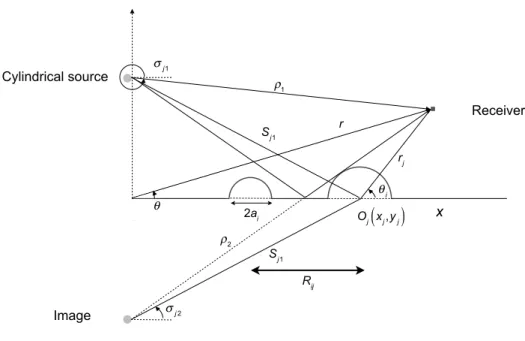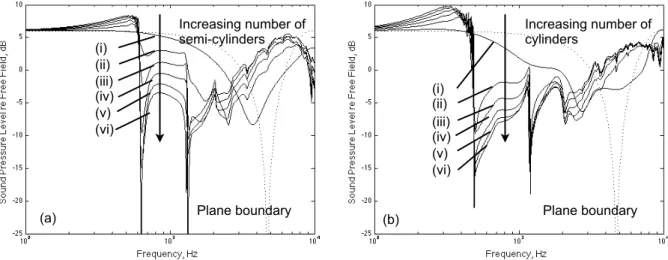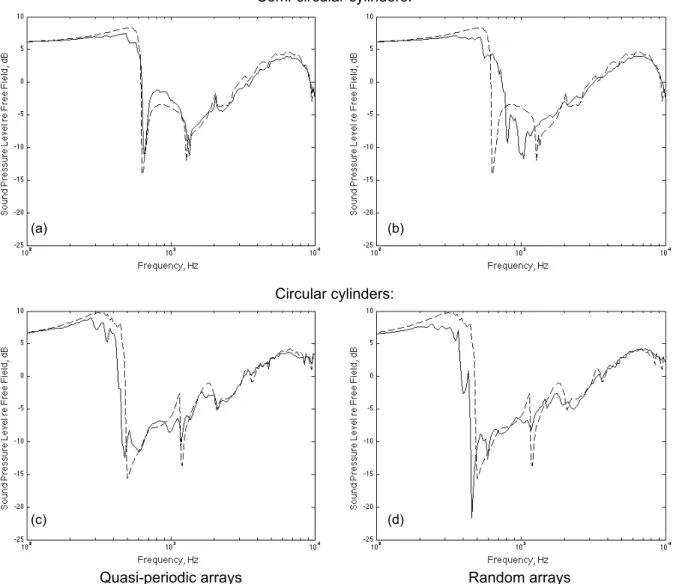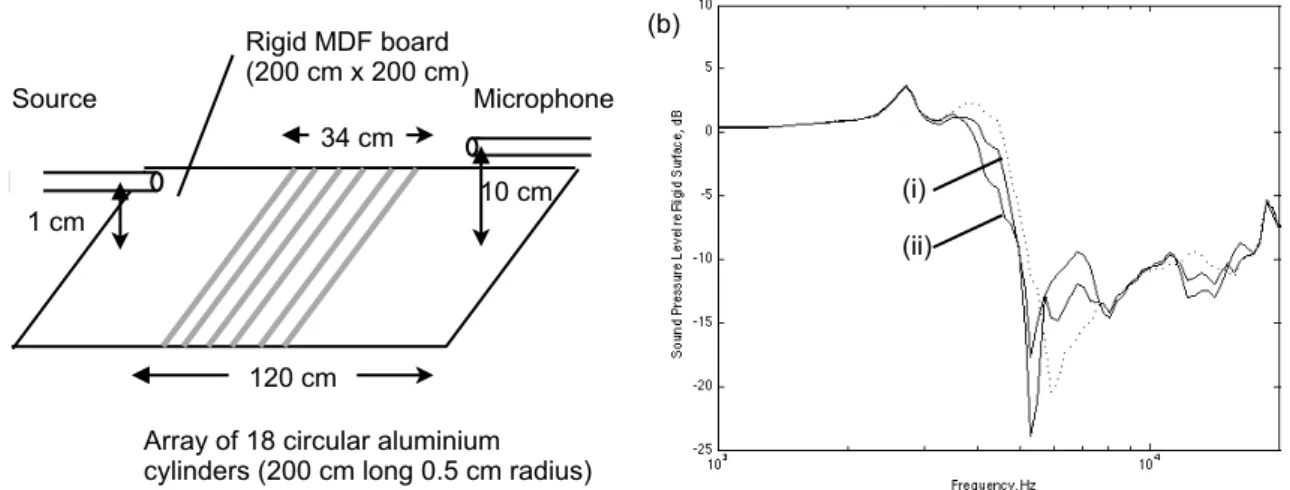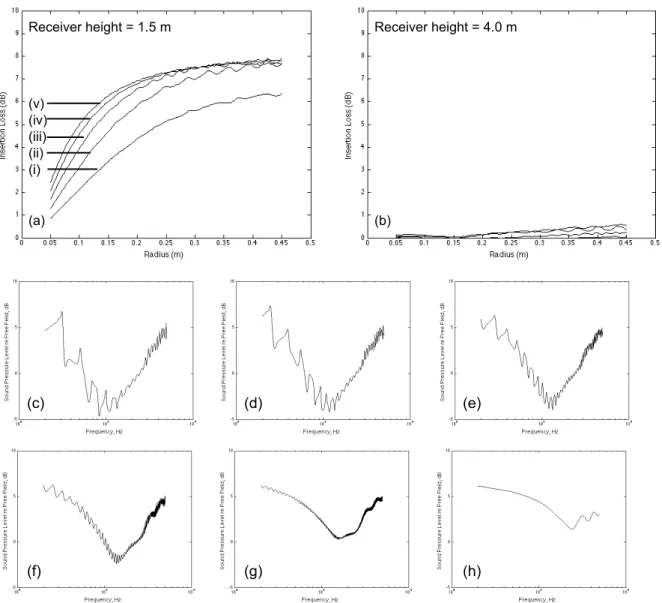ACOUSTIC PROPAGATION OVER PERIODIC AND
QUASI-PERIODIC ROUGH SURFACES
DL Berry,
GANC - IST, University of Lisbon & Department of Physics, University of Évora, Portugal S Taherzadeh, A Stronach & K Attenborough
School of Engineering and Innovation,The Open University, Milton Keynes, UK
1.
INTRODUCTION
Transport noise is an ever present concern in urban areas affecting the quality of life for millions of people. The traditional noise barrier is not always a convenient method of noise control and can divide communities. As a result, other types of barrier have been sought. Considerable interest has been devoted to the use of arrays of vertical cylinders1-3 especially as a result of the publication of
the measured transmission spectra of a minimalist sculpture4. A particular advantage in using such
arrays instead of conventional noise barriers is that they are relatively transparent and could be formed from natural means such as trees. However, such arrays do still present a barrier to pedestrian movement. Another approach is to use arrays of cylinders arranged horizontally on grounds near the noise source, the advantage being that they would allow greater pedestrian access and would be less intrusive. Such arrays effectively introduce a roughness to the ground, which is known to have a significant influence on near-grazing sound propagation5. Here we
present a theoretical and experimental investigation of this influence on sound propagation and its potential for transport noise reduction.
A theoretical treatment for analysing the sound propagation over such rough grounds considers the multiple scattering of cylindrical acoustic waves by an array of finite impedance semi-cylinders embedded in a smooth acoustically hard surface6 and is based on a treatment for the problem of
plane wave scattering by finite arrays of hard cylinders in water7 and on a treatment for identical
finite impedance cylinders8. Results from this treatment demonstrate good agreement between
predictions and measured relative sound pressure level spectra for a range of different array distributions and with boundary element calculations. It is this treatment that we adopt in this study. In section 2, we present an overview of this multiple scattering treatment. In section 3, we present results of this theoretical treatment for different source-receiver geometries, forms and sizes of both cylinders and semi-cylinders together with results of some simple laboratory measurements. An important challenge for this technique is to determine the optimum cylinder geometry which reduces noise over a large bandwidth without introducing low-frequency surface waves. In section 4, we review the potential for this technique as a way of reducing transport noise and propose some suggestions for further research.
2.
THEORY
The theoretical development presented in this article follows that of a multiple scattering approach presented previously6. Here, we consider a cylindrical wave incident from a single source on an
array of N rigid semi-cylinders (instead of N different finite impedance semi-cylinders) of variable radii that are embedded in a flat hard plane and arranged perpendicularly to the direction of propagation. Figure (1) shows the geometrical arrangement of the source, receiver and rigid semi-cylinders embedded in a plane boundary.
The total field at the receiver is the sum of a direct field contribution, a contribution from the plane boundary and a contribution from the semi-cylindrical scatterers and must satisfy the Helmholtz equation
Assuming a direct field represented by a Hankel function ! and a plane boundary reflected wave taken into account by assuming an image source ! , we can develop the following expression for the wave scattered by the finite array of cylinders
!
(2) provided that ! and ! . The application of boundary conditions for a rigid surface both on the surface of the semi-cylinders and the plane boundary, leads to an infinite system of equations for coefficients !
! (3)
with unknowns ! and ! , ! . To determine the coefficients ! , this infinite system of equations is truncated to a system of !
! (4) H0
( )
k0ρ1 H0( )
k0ρ2 P= Jn( )
k0rs n=−∞ +∞∑
einθs H n(
k0Ss1)
e −inσs1+ H n(
k0Ss 2)
e −inσs 2 ⎡ ⎣ ⎤⎦ + An sH n( )
k0rs n=−∞ +∞∑
einθs + Jm( )
k0rs Hn−m( )
k0Rjs m=−∞ +∞∑
eimθsei n( )−mαjs n=−∞ ∞∑
j=1 j≠s N∑
rs < Ss1 rs < Ss 2 AmP Ams + A n j n=−∞ ∞∑
j=1 j≠s N∑
Hn−m( )
kRjs ei n( )−mαjs = −H m( )
kSp1 e −imσp1− H m( )
kSp2 e −imσp 2 Anj m∈Z s = 1,…,N A n j N 2M(
+1)
Ams + A n j n=−M M∑
j=1 j≠s N∑
Hn−m( )
kRjs ei n( )−mαjs = −H m( )
kSp1 e −imσp1− H m( )
kSp2 e −imσp 2Figure 1: Source/receiver geometry used in theoretical development (after Boulanger et al, 2005 )
Cylindrical source r ρ1 Receiver ρ2 Rij x Sj1 rj O Image Sj1 θj σj 2 σj1 θ 2a i Oj
( )
xj,yjwhere !
!
and !
.
The procedure for determining the total field at a certain point using this multiple scattering approach requires solving the system of equations (3) by truncation and determining the pressure by summation using equation (2).
3.
NUMERICAL PREDICTIONS AND COMPARISON WITH
MEASUREMENTS
3.1. Propagation over Arrays of Semi-circular and Circular Cylinders
Using equations (2)-(4) we have made predictions for the influence of semi-cylinders and, as a comparison, circular cylinders for different radii on the propagation of sound from a cylindrical source. The source-receiver separation, d is 11m, the source height, S is 0.2m and the receiver height, R is 1.0m (Figure 2). The array elements are arranged in a 5m-wide strip at 1m from the source with their axes perpendicular to the direction of propagation of the cylindrical waves.
Figure 3 shows the predicted relative sound pressure level spectra over an evenly arranged, periodic distribution of semi-circular cylinders and circular cylinders where the number of elements is gradually increased from 1 to 21 in increments of 4.
m= −M,…,+M s= 1,…,N
Figure 3 Predictions from the multiple-scattering theory for the sound pressure level spectra over distributions of acoustically hard (a) semi-circular cylinders and (b) circular cylinders embedded in a rigid plane. The source-receiver separation, d = 11.0m, the source height, S = 0.2m and the receiver height, R = 1.0m. The solid lines indicate the effect of increasing the number of cylinders on the SPL positioned at 1m from the source at spacings of 0.25m (i) 1 cylinder, (ii) 5 cylinders, (iii) 9 cylinders, (iv) 13 cylinders (v) 17 cylinders (vi) 21 cylinders.
Plane boundary (i) (ii) (iii) (iv) (v) (vi) Increasing number of semi-cylinders Plane boundary Increasing number of cylinders (i) (ii) (iii) (iv) (v) (vi) (a) (b)
Figure 2 Source-receiver configuration used for both the theoretical and experimental investigations
y x Receiver Air Plane Boundary Cylindrical source d S R Semi-cylinders/cylinders placed perpendicular to direction of propagation
Also included in these two graphs is the SPL spectra over a rigid plane boundary. What these two graphs show is that the presence of an array of semi-circular or circular cylinders modifies the spectrum of that for propagation over plane rigid boundary. The first minimum of the sound pressure level for the plane rigid boundary has effectively been broadened out and its frequency reduced. With the exception of the spectrum for one element, the spectra have a spiky character with very pronounced minima at approximately 600 Hz and 1400 Hz for the semi-circular cylinder arrays and 500 Hz and 1100 Hz for the circular cylinder arrays. For applications in noise reduction, the problem of reducing these spikes can be achieved by covering the elements with sound absorbing material3.
These graphs also indicate that at low frequencies - at approximately 500 Hz for the semi-circular cylinder arrays and 300 Hz for circular cylinder arrays, a surface wave starts to appear - effectively introducing a low frequency hum - and becomes increasingly significant with increasing numbers of array elements. It is proposed that this effect could be reduced by altering the geometry of the elements - either by introducing “vacancies” in the periodic arrays ( “quasi-periodic” arrays) or by removing the periodicity of the elements (“random” arrays).
Figure 4 Predictions from the multiple-scattering theory for the SPL spectra over distributions of acoustically hard semi-circular cylinders ((a) and (b)) and circular cylinders ((c) and (d)) embedded in a rigid plane (dotted lines). Same source-receiver configuration as for Figure 3. These spectra are equivalent to the spectra (vi) in Figure 3(a) and (b). The solid lines in (a) and (c) demonstrate the effect of introducing 5 randomly chosen “vacancies” in the arrays of periodic elements and the solid lines in (b) and (d), the effect of distributing the elements randomly. In all spectra, a reduction in the surface wave contribution can be observed.
(a) (b)
(c) (d)
Semi-circular cylinders:
Circular cylinders:
Figure 4 shows the effect on the predicted relative sound pressure level spectra by introducing vacancies in the arrays and by completely randomising the arrays. For the semi-circular cylinders, the effect of vacancy inclusion and randomising the elements gives some 3 to 4 dB reduction in the range of 300 to 600 Hz. For the circular cylinders, this effect seems to be much more - some 5 to 10 dB reduction in the range 100 to 500 Hz.
Initial experiments carried out in a semi-anechoic chamber and far from any reflecting surfaces do support these numerical simulations. A free field 1/4” B&K microphone was positioned at 120 cm from a noise source and at a height of 10 cm above an MDF board which was considered effectively rigid (see Figure 5). The source, a Tannoy drive with a one metre long tube attached to it so that the end of the tube acts as a point source, was positioned at a height of 1 cm above the MDF board. An array of 18 200 cm long cylinders of 0.5 cm radius were positioned with a periodicity of 2 cm on the MDF board starting at 20 cm from the source. A measurement of sound field above this set of cylinders was made. Then two and three vacancies were created by removing every other tube (two and three tubes) from source side. this resulted in two patterns where vacancies exist in the periodic arrangement of the tubes. Sound fields were also measured above these new sets and were normalised with respect to sound field above the same (rigid) surface without any tubes. The resulting spectra can be called Insertion Loss or sound field (dB re rigid surface). Thus, 0 dB represents total reflection of sound from the hard surface and a level above 0 dB suggests existence of a surface wave, where the sound energy is trapped near the surface. The spectra are summarised in Figure 5b where the dotted line represents Insertion Loss of a periodic pattern while the solid lines are those of the two patterns with vacancies. The spike at 2.5 kHz is known to be an experimental error, while the surface wave component at around 4 kHz is present at periodic spectrum but greatly reduced in the spectra of patterns with missing elements.
3.2. A Possible Technique for Traffic Noise Reduction?
Figure 6 shows the predicted variation of the overall insertion loss for the frequency range 100 Hz to 5000 Hz as a function of radius for different numbers of semi-circular cylinders. The elements are distributed periodically over a 5 m strip with the first placed at 3 m from the source. The source height is 1 cm to represent tyre noise. Figure 6(a) and (b) are for the two values of receiver heights 1.5 and 4.0 m.
(i) (ii)
Figure 5 (a) Experimental arrangement for the measurement of sound pressure level over an array of 18 circular aluminium cylinders of 0.5 cm radii and 200 cm long, with a periodicity of 2 cm starting at 20 cm from the source on a rigid MDF board; source-receiver separation, d = 120 cm, source height, S = 1 cm and receiver height, R = 10 cm. (b) Results of measurement of sound pressure level taken with reference to the sound pressure level above the MDF board. Dotted line: results for the set of 18 cylinders; solid lines: results for the inclusion of (i) 2 and (ii) 3 vacancies.
1 cm
Array of 18 circular aluminium cylinders (200 cm long 0.5 cm radius)
34 cm 120 cm Microphone Rigid MDF board (200 cm x 200 cm) 10 cm Source (a) (b)
It is clear from Figure 6(a) that a limiting curve of insertion loss is reached with 5 - 6 semi-circular cylinders and with this amount of cylinders positioned in the 5 m strip at 3 m from the noise source, a radius of 0.15m to 0.2 m offers an overall insertion loss of 6 dB. The graphs in Figures 6(c) - (h) show how the relative sound pressure levels vary according to the number number of cylinders used for the particular circular cylinder radius of 0.175 m. Apart from (h) which is for 1 semi-circular cylinder positioned at 3 m from the source, the sound pressure level spectra show a pronounced minimum at 1-2 kHz.
If, however, the receiver is raised to heights approaching 4.0 m, the overall insertion loss reduces significantly (Figure 6(b)). This suggests that either there is a breakdown in the theory or that the cylinders play an insignificant role for large receiver heights.
Figure 6 Theoretical predictions for insertion loss and sound pressure levels for semi-cylinders placed perpendicularly to a cylindrical source. In (a) and (b), the overall insertion loss is predicted for five different semi-cylinder arrangements ((i) 2, (ii) 3, (iii) 4, (iv) 5 and (v) 6 semi-circular cylinders) where the cylinders are placed periodically over a 5 m strip with the first placed at 3 m from the source. The source-receiver separation is 20m, source height is 0.01 m and the receiver heights are: (a) 1.5 m, (b) 4 m. In (c)-(h), the sound pressure levels are shown for the source-receiver geometry presented in (a) with a semi-circular cylinder radius of 0.175 m: (c) 6, (d) 5, (e) 4, (f) 3, (g) 2, (h) 1 semi-circular cylinders. Receiver height = 1.5 m (a) (v) (iv) (iii) (ii) (i) (c) (d) (e) (f) (g) (h) Receiver height = 4.0 m (b)
4.
DISCUSSION
The numerical simulations using the multiple scattering model presented here demonstrate that arrays of semi-circular and circular cylinders arranged periodically and perpendicularly to a cylindrical source provide noise reducing capabilities over specific frequency bands. However, the introduction of the arrays - although reducing the sound pressure levels in the frequency band 1000 Hz to 1500 Hz - does provoke the appearance of slow waves at lower frequencies. This can be alleviated though by either introducing vacancies in the cylinder arrays (quasi-periodic distribution) or by removing the periodicity of the arrays altogether (random distribution).
For the application of reducing traffic noise, the numerical simulations presented do suggest that arrays of periodically distributed semi-circular cylinders can present reasonable insertion losses but these values are highly dependent upon the receiver height. At low receiver (pedestrian) heights this technique can give overall insertion losses of up to 6 dB but this drops of significantly with receiver height and the use of horizontally placed cylinders may not be appropriate for noise reduction for buildings.
Future work will consider methods for controlling the uniformity of the insertion loss as a function of frequency using horizontal arrays of cylinders. It has been demonstrated that periodic arrays of trees2 and especially those with highly porous bark do provide a more uniform insertion loss and it
is likely that coating arrays of horizontal cylinders with a porous material may similarly improve insertion loss uniformity (however, the choice of weather resistant porous material may be limited).
5.
ACKNOWLEDGMENTS
This work was developed while DLB was on sabbatical leave from the University of Évora and a Visiting Fellow at the Open University, January-June, 2016.
6.
REFERENCES
1. J.V. Sanchez-Perez, C. Rubio, R. Martinez-Sala, R. Sanchez-Grandia, and V. Gomez. Acoustic barriers based on periodic arrays of scatterers, App. Phys. Lett. 81, 5240-5242. (2002). 2. R. Martinez-Sala, C. Rubio, L.M. Garcia-Raffi, J.V. Sanchez-Perez, E.A. Sanchez-Perez and J.
Llinares. Control of noise by trees arranged like sonic crystals, J. Sound Vib. 291 100-106, (2006).
3. O. Umnova, K. Attenborough and C.M. Linton. Effects of porous covering on sound attenuation by periodic arrays of cylinders, J. Acoust. Soc. Am. 119 (1) (2006).
4. R. Martinez-Sala, J. Sancho, J.V. Sanchez, V. Gomez, J. Llinares. Sound attenuation by sculpture, Nature (London), 378, 241 (1995).
5. K. Attenborough and S. Taherzadeh. Propagation from a point source over a rough finite impedance boundary, J. Acoust. Soc. Am. 98, 1717-1722. (1995).
6. P. Boulanger, K. Attenborough, Q. Qin and C.M. Linton. Reflection of sound from random distributions of semi-cylinders on a hard plane: models and data, J. Phys. D: Appl. Phys. 38, 3480-3490 (2005).
7. C.M. Linton and V. Evans. The interaction of waves with arrays of vertical circular cylinders, J. Fluid Mech. 215, 549-69 (1990).
8. C.M. Linton and P.A. Martin. Multiple scattering by random configurations of circular cylinders: second-order corrections for the effective wave number, J. Acoust. Soc. Am. 117, 3413-3423 (2005).
9. P. Boulanger, K. Attenborough and Q. Quin. Effective impedance of surfaces with porous roughness: models and data. J. Acoust. Soc. Am. 117, 1146-56 (2005).
